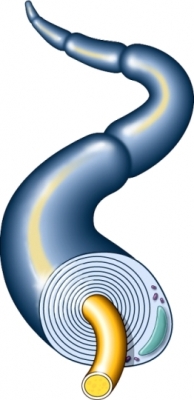X-linked adrenoleukodystrophy – Ald – Sudanofilnaya leukodystrophy – Schilder's disease
Description X-linked adrenoleukodystrophy
X-linked adrenoleukodystrophy (Ald) It is a rare hereditary genetic disease. Total described 34 type ALD. X-linked ALD is the most common form. ALD results in degeneration:
- Myelin sheath – fatty insulative coating on nerve fibers in the brain;
- The adrenal glands and surrounding adrenal cortex, that produce vital hormones.

Reasons adrenoleukodystrophy
ALD Call inherited defective gene.
In people with ALD body produces fatty acids in wrong proportions. This leads to an overabundance of saturated fatty acids in the brain and adrenal cortex. As a result, damage of the myelin sheath in the brain and adrenal glands.
Risk factors
Factors, which increase the risk of leukodystrophy sudanofilnoy, include:
- The presence of the mother of the defective gene with X-linked adrenoleukodystrophy;
- Age: childhood, age to adulthood;
- Paul: male, ALD rarely get sick.
The symptoms of X-linked adrenoleukodystrophy
Symptoms can vary depending on the type of ALD.
X-stsyeplyennaya blow (infantile cerebral ALD)
This form is the most severe. It is found only in boys. Symptoms usually begin between 2-10 years. About 35% patients may have severe symptoms at an early stage. Average, death occurs within two years. Some patients may live for decades.
Initial symptoms include:
- Behavioral changes;
- Memory impairment.
As the disease progresses, develop more severe symptoms. These include:
- Loss of sight;
- Seizures;
- Hearing loss;
- Difficulty swallowing and speaking;
- Difficulty in walking and coordination;
- Vomiting;
- Fatigue;
- Increased pigmentation (“Sun”) skin, due to adrenal hormone deficiency (Addison's disease);
- Progressive dementia;
- Vegetative state or death.
X-stsyeplyennaya blow (adolescent cerebral ALD)
This type is similar to the children's tserebralnuya ALD. It starts in 11 – 21 gg. and progresses, usually, slowly.
Adrenomielonevropatiâ (AMS)
This is the most common form. Symptoms of AMS may occur after 20 years. The disease progresses slowly and may include:
- Weakness, awkwardness, weight loss, nausea;
- Emotional disorders and depression;
- Problems with muscles (eg, difficulty walking);
- Sexual problems or impotence;
- Adrenal dysfunction;
X-stsyeplyennaya blow (adult cerebral ALD)
In this type of, symptoms usually rarely seen in young (to 20 years) or middle age (to 50 years). This form of ALD causes symptoms, similar to schizophrenia and dementia. The disease usually progresses rapidly. Death or a vegetative state can occur through 3-4 year.
Gyetyerozigotnaya forma blow
This form is found only in women. Symptoms may be mild or severe. On the functioning of the adrenal heterozygous form of ALD is usually not affected.
Diagnostic X-linked adrenoleukodystrophy
ALD is suspected and the following tests:
- Blood tests, to determine the level of fatty acids;
- MRI of the brain, to assess its condition and functionality.
Treatment of x-linked adrenolejkodistrofii
There is no treatment for x-linked adrenolejkodistrofii. But, adrenal deficiency can be treated with cortisone. ALD usually leads to death within 10 years after the onset of symptoms.
Some types of therapy can reduce symptoms ALD. Sometimes a pilot treatment.
Therapies to reduce symptoms ALD includes:
- physical therapy;
- psychological therapy;
- Special education (for children).
Some treatments include:
- bone marrow transplantation. This operation may be most useful when child cerebral ALD;
- Dietary therapy, that includes consumption:
- Products with a very low fat diet;
- Lorenzo's Oil – nutritional supplements based on a blend of oils gliceroltrioleata (GTO) and gliceroltrièrukata (GTE);
- Reception lovastatina – antiholesterinovogo drug.
Prevention of x-linked adrenolejkodistrofii
There is no way to prevent the occurrence of ALD. When the genetic background to the disease, you must decide on childbirth.
Early diagnosis and treatment can prevent the development of clinical symptoms. It is especially suitable for young boys, that treated oil Lorenzo. New technology may soon allow early identification of disease through screening.
